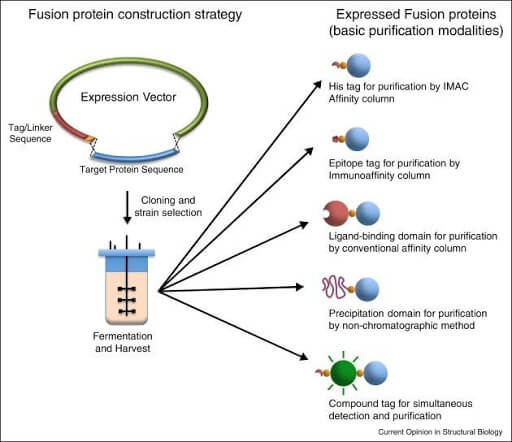Brief Introduction to Column Chromatography
The majority of modern bioprocesses rely on some form of chromatography to purify the protein or molecule of interest. Generally the product is expressed through a fermentation process and sent for subsequent downstream processing steps. Different types of chromatography are done sequentially to clean up the sample and achieve a pure product with high efficiency yields.
The type of product and its inherent chemistry often dictate the chromatography purification strategy employed. The sequential use of multiple column types in a bioprocess is essential for removing cellular debris, media components, and other by-products. The efficiency of column chromatography at the pilot and production scale is often a function of the column size, flow rate, and property of the resin being used.


Applications of Separation Chromatography
Column chromatography is an essential processing step in production of most modern medicines and biotherapeutics. Mono-clonal antibodies (MABs) are a high value therapeutic that is dependent on a series of columns/resins. The generalized process starts by expressing the MABs in a bio reactor, harvesting the cells, then going into a Protein A Column (primary recovery), and sequentially into Ion-Exchange and Hydrophobic interaction columns (polishing steps). The efficiency and efficacy of this process is crucial for a successful bioprocess.


Benefits of Radial Flow Chromatography (RFC) vs. Axial Flow Chromatography
With recent improvements in resin formulation/composition, the run/cycle time of chromatography has become a limiting step. Traditional axial flow columns work well at small volumes, but struggle with scale up. This can result in low flow rates and high back pressure in axial flow chromatography at scale. The Sepragen Radial flow columns offer a novel chromatographic technique that greatly increases throughput by maximizing column surface area with a short bed depth. The mechanism of RFC is similar to Tangential Flow Filtration, in RFC the flow is directed from the outer edge of the column in a radial direction through the resin bed to the column exit. This design allows RFC columns to be relatively short with a small footprint, allowing for high flow rates and low back-pressure. The RFC design pioneered by Sepragen solves the challenges of scaling up a traditional axial flow chromatography process.


Benefits of Single Use QuantaSep System
Many high value bioprocesses are transitioning to single use components as it is logistically easier and requires less documentation. The Sepragen QuantSep Single Use Systems offer unparalleled modularity and flexibility when it comes to single use chromatography.
The QuantaSep® 3000 SU system is mobile, compact, and capable of providing an operating flow range of 30-3000 ml/min. The integrated system has two peristaltic pumps, 8 buffer selection valves, an inline mixer, filters, and 6 fraction collection valves. Its capabilities include but are not limited to buffer switching, gradient formation, feed pre-filtering, air ejection, conductivity and pH sensing pre- and post-column, and forward and reverse flow in a powerful easy-to-use software package.

The software enables buffer and fraction switching based on process conditions and activates alarms in the event of overpressure, or air leaks. All events are automatically logged and archived. The QuantaSep® 3000 SU hardware is composed of control modules and a fluid handling combined into a single ergonomically-designed counter high cabinet. The bench top unit can be cart-mounted for easy mobility. The computer that houses the control software can be integrated with or separated from the system to provide the option of remote operation. The system is compatible with 1M NaOH and alcohol for CIP operations and is operable at 4°C for cold room processing.
The fluid handling module contains: 2 pump assemblies consisting of two peristaltic pumps, static mixer, and silicone tubing. These are connected with sanitary clamp connections to pinch valves, UV, pH, leak, conductivity, temperature and pressure sensors, air sensor, air purge valve, sanitary inlets, outlets, and column connections. The components are mounted inside an enclosed stainless steel cabinet with a trough to which a leak detector is attached.
The flowpath of this system is designed for easy removal. This eliminates the need for cleaning validation. Issues related to cross-contamination in switching columns or products are substantially minimized when the flowpath can simply be replaced. Pinch valves and peristaltic pumps enable easy changing of the prefabricated tubing assembly along with the integrated sensor block, which can be easily removed and replaced as well.

- Low system volume
- Minimal dead legs
- Six inlet quick disconnect buffer selection connections
- Six fraction quick disconnect Fraction selection connections
- Conductivity flow cell
- UV flow cell
- PH sensor
- Temperature sensor
- Peristaltic pump tubing
- Mixer
- Pressure sensor
Advantages of Sepragen Single Use and Sepragen Radial Flow Chromatography
- Save money on resins (small columns)
- Easy to do small modular batches of multiple products
- Flexibility of volume/batch size
- Faster runs
- Small Footprint
- Scale Up from 30 ml/min to 3L/min Easily
- No Cleaning Validation

